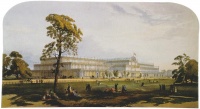Design
From The Art and Popular Culture Encyclopedia

|
"Art made by the people, and for the people"--William Morris "In the 20th century, as beauty was banned from the arts, it found refuge in consumer culture, cinema, Hollywood marketing, product design, advertising, fast-moving consumer goods, consumer electronics, and the car industry."--Sholem Stein "Modernist architects, in particular, took to their hearts the idea that 'ornament is crime', first professed by Adolf Loos, and ... Designers such as Duquette, Piero Fornasetti and David Hicks preferred a more expressive approach to the home, ..."--The Secret Life of the Modern House (2021) by Dominic Bradbury |
_.jpg)
|
Related e |
|
Featured: |
Design, usually considered in the context of the applied arts, engineering, architecture, and other such creative endeavors. In the context of this wiki design is defined as "the art of designing", as in Danish design of furniture is world-famous. As such, we will consider the fields of industrial design, graphic design, fashion design, interior design, and decorative art. Design differs from industrial design in that the latter is always meant for mass production, whereas the former may also mean one-off production.
Contents |
Design and art
Today the term design is widely associated with the Applied arts as initiated by Raymond Loewy and teachings at the Bauhaus and Ulm School of Design (HfG Ulm) in Germany during the 20th century.
The boundaries between art and design are blurred, largely due to a range of applications both for the term 'art' and the term 'design'. Applied arts has been used as an umbrella term to define fields of industrial design, graphic design, fashion design, etc. The term 'decorative arts' is a traditional term used in historical discourses to describe craft objects, and also sits within the umbrella of Applied arts. In graphic arts (2D image making that ranges from photography to illustration) the distinction is often made between fine art and commercial art, based on the context within which the work is produced and how it is traded.
To a degree, some methods for creating work, such as employing intuition, are shared across the disciplines within the Applied arts and Fine art. Mark Getlein suggests the principles of design are "almost instinctive", "built-in", "natural", and part of "our sense of 'rightness'." However, the intended application and context of the resulting works will vary greatly.
Related
applied arts - architecture - car - cult objects - decorative arts - fashion - furniture - "good design" - graphic design - industrial design - interior design - kitsch - object - product - technology
Movements: Arts & crafts (1880 - 1920) - Machine Age (1880 - 1945) - art nouveau (1880-1905) - Streamline Moderne (1925-1950) - Art Deco (1925-1950) - Atomic Age - Bauhaus (1920-1930) - International Style - Jet Age - Space Age - Pop art (1960-1980) - Memphis Design group - postmodernism
Designers: Joe Colombo - Luigi Colani - Ray and Charles Eames - Piero Fornasetti - Carlo Mollino - Gaetano Pesce - Dieter Rams - Ettore Sottsass
Connoisseurs: Reyner Banham (1922–1988) - Klaus-Jürgen Sembach (1933 - 2020) - Victor Arwas (1937- 2010) - John Heskett (1937 – 2014) - Charlotte Fiell and Peter Fiell - Stephen Bayley - Philippe Garner - Bevis Hillier - Penny Sparke - Agata Toromanoff - Gabriele Fahr-Becker - Alastair Duncan
Magazines: Domus magazine
See also
By region
- Dutch design
- Italian design
- American design
- Scandinavian design
- The Style of the Century: 1900-1980 (1983) by Bevis Hillier

.jpg)


